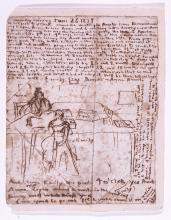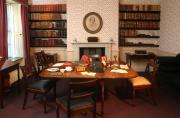Conservation of the manuscripts of Emily Brontë
Emily Brontë, along with her sisters Charlotte and Anne, is ranked amongst the world’s greatest novelists. Emily was also a poet, and one of the items to be conserved is a collection of original drafts of some of her best-known poems. These were written on tiny scraps of paper in miniscule script and set into a handsome leather-bound volume by Henry Houston Bonnell, the American collector who bequeathed his magnificent collection of Brontëana to the Brontë Society in 1927. In the years since the collection returned to Haworth, the pages onto which the manuscripts are inlaid have begun to degrade, causing pollutants to affect the precious manuscripts.
Also selected for conservation treatment are two rare diary papers, each offering a vivid glimpse of daily life at Haworth Parsonage and amongst the key items in the museum’s collection. The first of these, written by Emily and Anne Brontë in 1834, is also part of the Bonnell collection and, like the poetry manuscripts, bound into a volume. The second is by Emily alone, dating from 1837 and including a sketch showing herself and Anne writing at the dining room table.
Once cleaned and removed from their poor quality inlay papers and backings, the manuscripts can be exhibited on their own. 2018 marks the bicentenary of Emily Brontë’s birth and offers many exciting opportunities to display the manuscripts and maximise access to them.
This grant was made possible thanks to the support of the Pilgrim Trust
All images courtesy of the Brontë Society

